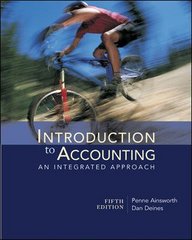Question
Chapter 11 provides a problem to address this situation for an investor by the name of Rhonda. It is important to be able to do
Chapter 11 provides a problem to address this situation for an investor by the name of Rhonda. It is important to be able to do the accounting and tax work for these types of investments but to also provide advice to clients. Accordingly, this problem is an expansion on the Rhonda problem in the book. Rhonda has $25,000 to invest. (She feels that the investment will pay off in the long run.) Based on her research and discussion with friends, Rhonda has identified two strategies.
Rhonda needs your advice. Provide an answer to Rhonda's question as to whether either of the investment strategies in year 2 help her situation. You can also identify another option for her investment of $25,000. For each part compute the losses that can be deducted each year, the balance of the deferred losses (if any), and a summary of the amounts invested and the losses taken. Make a schedule to summarize this using the template attached here, also in D2L Content - Notes. (The schedule will provide support for your recommendation.)
Strategy a. Assume that Rhonda invested $9,000 in this (passive activity) entity in year 0. Rhonda's share of the year 0 loss was 1,500. This should bring you to the initial status in the problem in the text. As with the problem, assume that Rhonda's share of the loss was 12,000 in year 1. Then go forward from this point and assume that in year 2, Rhonda invests an additional $25,000 in year 2 (to address the basis limitation rule) and the entity generates another $12,000 loss (her share). Does this help Rhonda? What are her ending balances?
Strategy b. Begin as in part a. Assume that Rhonda invested 9,000 in this (passive activity) entity in year 0. Rhonda's share of the year 0 loss was 1,500. This should bring you to the initial status in the problem in the text. As with the problem, assume that Rhonda's share of the loss was 12,000 in year 1. Then go forward from this point and assume that in year 2, Rhonda invests an additional $15,000 into this entity and also invests another $10,000 into a different entity that generates $5,000 of passive income? Does that help Rhonda? What are her ending balances?
Other strategy -- is there a better approach for her to invest the $25,000?
Chap 11 reference
Rhondahas an adjusted basis and an at-risk amount of $7,500 in a passive activity at the beginning of the year. She also has a suspended passive activity loss of $1,500 carried over from the prior year. During the current year, she has a loss of $12,000 from the passive activity.Rhondahas no passive activity income from other sources this year. Determine the following items relating toRhonda's passive activity as of the end of the year.
- Adjusted basis and at-risk amount in the passive activity.
- Loss suspended under the at-risk rules.
- Suspended passive activity loss.
Step by Step Solution
There are 3 Steps involved in it
Step: 1

Get Instant Access to Expert-Tailored Solutions
See step-by-step solutions with expert insights and AI powered tools for academic success
Step: 2

Step: 3

Ace Your Homework with AI
Get the answers you need in no time with our AI-driven, step-by-step assistance
Get Started


